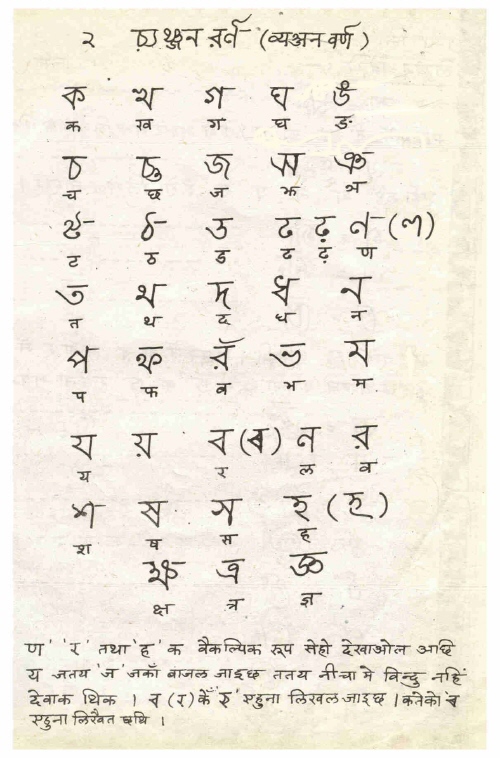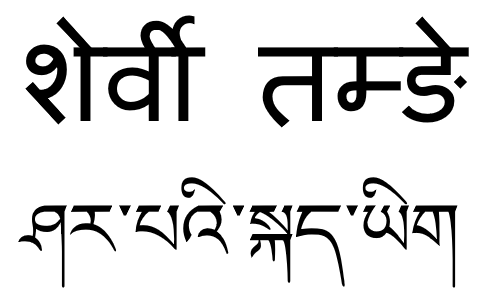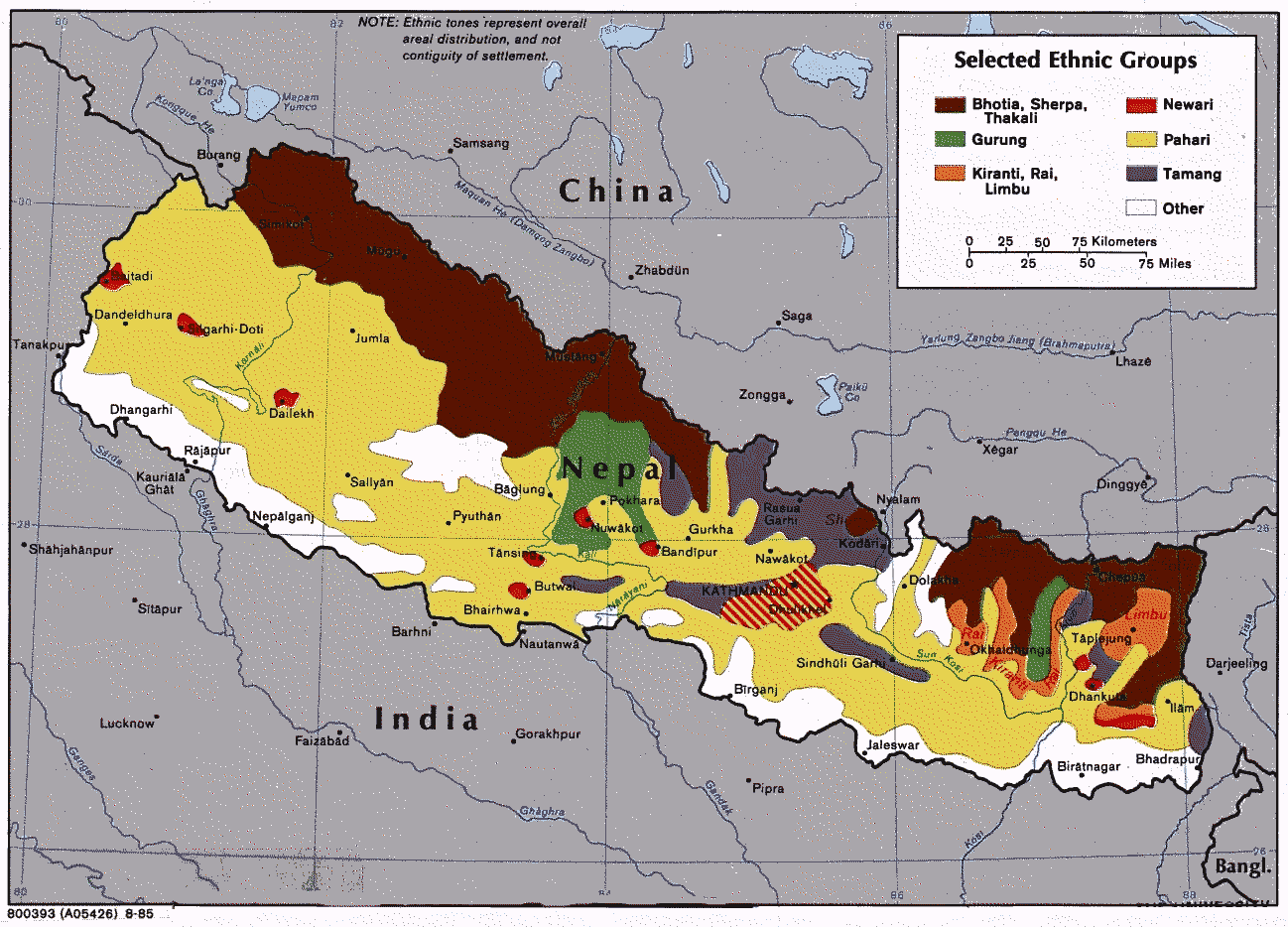|
Tamakoshi Rural Municipality
Tamakoshi is a rural municipality located within the Dolakha District of the Bagmati Province of Nepal. The municipality spans of area, with a total population of 18,849 according to a 2011 Nepal census. On March 10, 2017, the Government of Nepal restructured the local level bodies into 753 new local level structures. The previous Bhirkot, Jhule, Japhe, Malu, Sahare, Chyama and Hawa VDCs were merged to form Tamakoshi. Tamakoshi is divided into 7 wards, with Japhe declared the administrative center of the rural municipality. Demographics At the time of the 2011 Nepal census, Tamakoshi Rural Municipality had a population of 18,849. Of these, 87.4% spoke Nepali, 5.3% Sunwar, 4.2% Tamang, 1.4% Sherpa, 0.9% Majhi, 0.2% Maithili, 0.2% Newar and 0.2% other languages as their first language. In terms of ethnicity/caste, 43.2% were Chhetri, 19.0% Hill Brahmin, 6.6% Sarki, 6.0% Kami, 5.5% Sunuwar, 4.7% Newar, 4.4% Tamang, 3.0% Damai/Dholi, 2.3% Damai/Dholi, 1.4% Majhi ... [...More Info...] [...Related Items...] OR: [Wikipedia] [Google] [Baidu] |
Gaunpalika
A gaunpalika ( ne, गाउँपालिका, lit=rural municipality, translit=Gāum̐pālikā ) is an administrative division in Nepal. The Ministry of Federal Affairs and Local Development dissolved the existing village development committees and announced the establishment of this new local body. It is a sub-unit of a district. There are currently 460 rural municipalities. History The village development committee was the previous governing body of villages in Nepal. They were replaced on 10 May 2017 by the rural municipalities which were formed by combining different VDCs. The decision was taken by the cabinet of Nepal after modifications in the report proposed by the Local Level Restructuring Commission. Initially 481 rural municipalities were formed but it was later changed to 460 municipalities. According to the Ministry of Federal Affairs and Local Development the new bodies were to be called "rural municipality" and not "village council" which was the literal tran ... [...More Info...] [...Related Items...] OR: [Wikipedia] [Google] [Baidu] |
Chyama
Chyama is a village development committee in Dolakha District in the Janakpur Zone of north-eastern Nepal. At the time of the 1991 Nepal census The 1991 Nepal census was a widespread national census conducted by the Nepal Central Bureau of Statistics. Working with Nepal's Village Development Committees at a district level, they recorded data from all the main towns and villages of each ... it had a population of 2,419 people living in 479 individual households.. References External linksUN map of the municipalities of Dolakha District Populated places in Dolakha District {{Dolakha-geo-stub ... [...More Info...] [...Related Items...] OR: [Wikipedia] [Google] [Baidu] |
Sarki (ethnic Group)
Sarki/Mijar ( ne, सार्की, Tibetan: སར་ཀི།) is a Khas occupational caste traditionally belonging to leather workers. They are found in the region of the Himalayas, Nepal, across the hills of Darjeeling & Kalimpong and in Terai area of Dooars. They are experts in playing their musical instrument "Madal" and performing dance in a group which is also called “Khayali Marooni”. According to the 2011 Nepal census, Sarki makes up 1.4% of Nepal's population (374,816 people). Sarki are referred to in the Nepali and Thakali languages. Due to many caste-based discriminations in Nepal, the government of Nepal legally abolished the caste-system and criminalized any caste-based discrimination, including "untouchability" (the ostracism of a specific caste) - in the year 1963 A.D. With Nepal's step towards freedom and equality, Nepal, previously ruled by a Hindu monarchy, was a Hindu nation which has now become a secular state, and on 28 May 2008, it was declared a ... [...More Info...] [...Related Items...] OR: [Wikipedia] [Google] [Baidu] |
Bahun
Bahun ( ne, बाहुन) or Khas Brahmin ( ne, खस ब्राह्मण) is a caste ( ''Varna'') among Khas people of Nepal. Their origins are from the Indo-Aryan Khasa tribe of Nepal and South Asia. According to the 2011 Nepal census, Bahun is the second most populous group after Chhetri, another Varna within the hill Hindus in Nepal. According to 1854 ''Muluki Ain'' (Nepalese Legal Code), Bahuns were regarded as caste among sacred thread bearers (Tagadhari) and twice-born Hindus. Origin Traditionally, Bahuns were members of the Khas community together with Chhetris and Hill Dalits. Possibly due to political power of the Khasa Malla kingdom, Khas Bahun and Khas Rajput (Chhetris) had high social status like plain Brahmins and Rajputs in the present-day western Nepal. Bahuns, regarded as upper class Khas group together with Chhetri, were associated mostly with the Gorkha Kingdom. Bahuns were original inhabitants of Karnali region of Nepal. The immigration ... [...More Info...] [...Related Items...] OR: [Wikipedia] [Google] [Baidu] |
Chhetri
Chhetri (Kshetri, Kshettri, Kshetry or Chhettri), ( ne, क्षेत्री ; IAST: ''Kṣetrī'') historically called Kshettriya or Kshetriya or Khas are Nepali speakers of Khas community, some of whom trace their origin to migration from medieval India. Chhetri was a caste of administrators, governor and military elites in the medieval Khas Kingdom and Gorkha Kingdom (later unified Kingdom of Nepal). The nobility of the Gorkha Kingdom mainly originated from Chhetri families. They also had a strong presence in civil administration affairs. The bulk of prime ministers of Nepal before the democratization of Nepal belonged to this caste as a result of the old Gorkhali aristocracy. Gorkha-based aristocratic Chhetri families included the Pande dynasty, the Basnyat dynasty, the Kunwar family, and the Thapa dynasty, (Rana dynasty and other Kunwars). Khas Chhetris were traditionally considered a division of the Khas people with Khas Brahmin (commonly called Khas Bahun). They m ... [...More Info...] [...Related Items...] OR: [Wikipedia] [Google] [Baidu] |
Newar Language
Newar (), or Newari and known officially in Nepal as Nepal Bhasa, is a Sino-Tibetan language spoken by the Newar people, the indigenous inhabitants of Nepal Mandala, which consists of the Kathmandu Valley and surrounding regions in Nepal. "Nepal Bhasa" literally means "Nepalese language", however the language is not the same as Nepali (Devanāgarī: नेपाली), the country's current official language of the central government. The two languages belong to different language families (Sino-Tibetan and Indo-European, respectively), but centuries of contact have resulted in a significant body of shared vocabulary. Newar was Nepal's administrative language from the 14th to the late 18th century. From the early 20th century until democratisation, Newar suffered from official suppression. From 1952 to 1991, the percentage of Newar speakers in the Kathmandu Valley dropped from 75% to 44% and today Newar culture and language are under threat. The language has been listed ... [...More Info...] [...Related Items...] OR: [Wikipedia] [Google] [Baidu] |
Maithili Language
Maithili () is an Indo-Aryan language spoken in parts of Languages of India, India and Languages of Nepal, Nepal. It is native to the Mithila region, which encompasses parts of the Indian states of Bihar and Jharkhand as well as Nepal's eastern Terai. It is one of the 22 Eighth Schedule to the Constitution of India, officially recognised languages of India and the second most spoken Languages of Nepal, Nepalese language in Nepal. The language is predominantly written in Devanagari, but there were two other historically important scripts: Tirhuta script, Tirhuta, which has retained some use until the present, and Kaithi script, Kaithi. Official status In 2003, Maithili was included in the 8th Schedule, Eighth Schedule of the Indian Constitution as a recognised language of India, Indian language, which allows it to be used in education, government, and other official contexts in India. Maithili language is included as an optional paper in the Union Public Service Commission, UP ... [...More Info...] [...Related Items...] OR: [Wikipedia] [Google] [Baidu] |
Majhi Language
Majhi is an Indo-Aryan language spoken in parts of Nepal and formerly in some small pockets of neighboring India.:1 The language is associated with the Majhi people, an ethnic group in those regions who dwell historically near the Saptakoshi River and its tributaries and elsewhere in central and eastern Nepal. The Majhi people generally subsist off of work associated with rivers, including fishing and ferrying.:2 Majhi is written using the Devanagari writing system. Ethnologue classifies Mahji as a 6b threatened language. There are roughly 24,400 L1 speakers of Majhi in Nepal and roughly 46,120 L1 and L2 speakers of the language around the globe. Most of the Majhi speakers in Nepal are bilingual with the more predominant Nepali language,:2 and the latter language is replacing Majhi in use. Majhi's lack of official status, use in education, in media, in print, etc. places the survival of the language in a precarious position.:2 The last speaker in India, Thak Bahadur Majhi of Jor ... [...More Info...] [...Related Items...] OR: [Wikipedia] [Google] [Baidu] |
Sherpa Language
Sherpa (also Sharpa, Xiaerba, or Sherwa) is a Tibetic language spoken in Nepal and the Indian state of Sikkim, mainly by the Sherpa. The majority speakers of the Sherpa language live in the Khumbu region of Nepal, spanning from the Chinese (Tibetan) border in the east to the Bhotekosi River in the west. About 200,000 speakers live in Nepal (2001 census), some 20,000 in Sikkim (1997) and some 800 in Tibetan Autonomous Region (1994). Sherpa is a subject-object-verb (SOV) language. Sherpa is predominantly a spoken language, although it is occasionally written using either the Devanagari or Tibetan script. Phonology Sherpa is a tonal language. Sherpa has the following consonants: Consonants * Stop sounds can be unreleased in word-final position. * Palatal sounds can neutralize to velar sounds when preceding . * can become a retroflex nasal when preceding a retroflex stop. * can have an allophone of when occurring in fast speech. Vowels * Vowel sounds have the ... [...More Info...] [...Related Items...] OR: [Wikipedia] [Google] [Baidu] |
Tamang Language
Tamang (Devanagari: तामाङ; ''tāmāng'') is a term used to collectively refer to a dialect cluster spoken mainly in Nepal, Sikkim, West Bengal (Darjeeling) and North-Eastern India. It comprises Eastern Tamang, Northwestern Tamang, Southwestern Tamang, Eastern Gorkha Tamang, and Western Tamang. Lexical similarity between Eastern Tamang (which is regarded as the most prominent) and other Tamang languages varies between 81% to 63%. For comparison, lexical similarity between Spanish and Portuguese, is estimated at 89%. Ethnologue report for Spanish Dialects ''Ethnologue'' divides Tamang into the following varieties due to mutual unintelligibility. *Eastern Tamang: 759,000 in Nepal (2000 WCD). Population total all countries: 773,000. Sub-dialects are as follows. **Outer-Eastern Tamang (Sailung Tamang) **Central-Eastern Tamang (Temal Tamang) **Southwestern Tamang (Kath-Bhotiya, Lama Bhote, Murmi, Rongba, Sain, Tamang Gyoi, Tamang Gyot, Tamang Lengmo, Tamang Tam) *Western T ... [...More Info...] [...Related Items...] OR: [Wikipedia] [Google] [Baidu] |
Sunwar Language
Sunuwar, Sunuwar, or Kõinch (; ; other spellings are Koinch and Koincha), is a Kiranti language spoken in Nepal and India by the Sunuwar people. It was first comprehensively attested by the Himalayan Languages Project. It is also known as Kõits Lo ( ; ), Kiranti-Kõits ( ; ), Mukhiya ( ; ). The Sunwar language is one of the smaller members of the Tibeto-Burman language family. About 40,000 speakers are residing in eastern Nepal. Names The language is commonly known as ''Koic,'' for many ethnic Sunwar and Sunwar speakers also refer to the language as “''Sunuwar, Kõinch'' '', Koinch'' or ''Koincha'' (कोँइच); ''Kõits Lo'' (कोँइच लो), ''Kiranti-Kõits'' (किराँती-कोँइच) or ''Mukhiya'' (मुखिया).” Moreover, most Sunwar speakers have the surname (सुनुवार), ''Sunuvār'' in Latin script. Many affiliated Sunwar with Sunar; they share the initial syllable, ''sun'', “gold,” in Nepali, similar to the S ... [...More Info...] [...Related Items...] OR: [Wikipedia] [Google] [Baidu] |
Nepali Language
Nepali (; , ) is an Indo-Aryan language native to the Himalayas region of South Asia. It is the official, and most widely spoken, language of Nepal, where it also serves as a '' lingua franca''. Nepali has official status in the Indian state of Sikkim and in the Gorkhaland Territorial Administration of West Bengal. It is spoken by about a quarter of Bhutan's population. Nepali also has a significant number of speakers in the states of Arunachal Pradesh, Assam, Himachal Pradesh, Manipur, Meghalaya, Mizoram and Uttarakhand. In Myanmar it is spoken by the Burmese Gurkhas. The Nepali diaspora in the Middle East, Brunei, Australia and worldwide also use the language. Nepali is spoken by approximately 16 million native speakers and another 9 million as a second language. Nepali is commonly classified within the Eastern Pahari group of the Northern zone of Indo-Aryan. The language originated from the Sinja Valley, Karnali Province then the capital city of the Khasa K ... [...More Info...] [...Related Items...] OR: [Wikipedia] [Google] [Baidu] |






